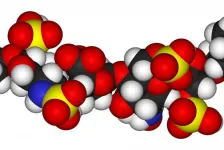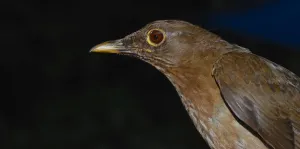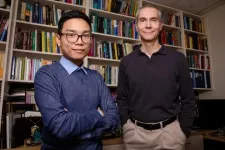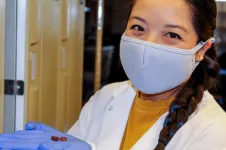INFORMATION:
For more information, please contact Tony Moran, International Communications Manager, University of Birmingham on +44 (0)782 783 2312 or t.moran@bham.ac.uk. For out-of-hours enquiries, please call +44 (0) 7789 921 165.
PHOTO CAPTIONS - please credit 'University of Birmingham':
Reconstruction of the crown of Paratingia wuhaia sp. nov.
This reconstruction is based on the type specimen from the Wuda Tuff Flora and shows what scientist think the plant looked like when it was alive. Reconstruction of the peat-forming plant community at Wuda in which the new species Paratingia wuhaia (yellow arrows) grew.
Fossil specimen of the new species preserving the crown of the tree with leaves and its fertile organs attached to the stem.
Notes to Editors
The University of Birmingham is ranked amongst the world's top 100 institutions, its work brings people from across the world to Birmingham, including researchers and teachers and more than 6,500 international students from over 150 countries.
The Birmingham Institute of Forest Research supports natural science, social science, and cultural scholarship investigating forested landscapes now, in the past, and in the future.
'Ancient noeggerathialean reveals the seed plant sister group diversified alongside the primary seed plant radiation' - Jun Wang, Jason Hilton, Hermann W. Pfefferkorn, Shijun Wang, Yi Zhang, Jiri Bek, Josef Pšenička, Leyla J. Seyfullah, David Dilcher is published in Proceedings of the National Academy of Sciences (PNAS).
The research team was made up of experts from: Nanjing Institute of Geology and Palaeontology; University of Birmingham; Chinese Academy of Sciences; Shenyang Normal University; Academy of Sciences of the Czech Republic, Prague; Centre of Palaeobiodiversity, Plze?, Czech Republic; University of Vienna; Indiana Geological and Water Survey, US; and Indiana University, US.
'Pompeii of prehistoric plants' unlocks evolutionary secret -- study
2021-03-08
(Press-News.org) Spectacular fossil plants preserved within a volcanic ash fall in China have shed light on an evolutionary race 300 million years ago, which was eventually won by the seed-bearing plants that dominate so much of the Earth today.
New research into fossils found at the 'Pompeii of prehistoric plants', in Wuda, Inner Mongolia, reveals that the plants, called Noeggerathiales, were highly-evolved members of the lineage from which came seed plants.
Noeggerathiales were important peat-forming plants that lived around 325 to 251 million years ago. Understanding their relationships to other plant groups has been limited by poorly preserved examples until now.
The fossils found in China have allowed experts to work out that Noeggerathiales are more closely related to seed plants than to other fern groups.
No longer considered an evolutionary dead-end, they are now recognized as advanced tree-ferns that evolved complex cone-like structures from modified leaves. Despite their sophistication, Noeggerathiales fell victim to the profound environmental and climate changes of 251 million years ago that destroyed swamp ecosystems globally.
The international research team, led by palaeontologists at Nanjing Institute of Geology and Palaeontology and the University of Birmingham, today published its findings in the Proceedings of the National Academy of Sciences (PNAS).
Co-author Dr. Jason Hilton, Reader in Palaeobiology at the University of Birmingham's Institute of Forest Research, commented: "Noeggerathiales were recognized as early as the 1930s, but scientists have treated them as a 'taxonomic football', endlessly kicked around without anyone identifying their place in the Story of Life.
"The spectacular fossil plants found in China are becoming renowned as the plant equivalent of Pompeii. Thanks to this slice of life preserved in volcanic ash, we were able to reconstruct a new species of Noeggerathiales that finally settles the group's affinity and evolutionary importance.
"The fate of the Noeggerathiales is a stark reminder of what can happen when even very advanced life forms are faced with rapid environmental change."
The researchers studied complete Noeggerathiales preserved in a bed of volcanic ash 66 cm thick formed 298 million years ago, smothering all the plants growing in a nearby swamp.
The ash stopped the fossils from rotting or being consumed, and preserved many complete individuals in microscopic detail.
Lead-Author Jun Wang, Professor of Palaeobotany at Nanjing Institute of Geology and Palaeontology, commented: "Many specimens were identified in excavations in 2006-2007 when a few leaves were visible on the surface of the ash. It looked they might be connected to each other and a stem below - we revealed the crown on site, but then extracted the specimens complete to take them back to the lab.
"It has taken many years to study these fully and the additional specimens we have found more recently. The complete trees are the most impressive fossil plants I have seen and because of our careful work they are also some of the most important to science."
The researchers also deduced that that the ancestral lineage from which seed plants evolved diversified alongside the earliest seed plant radiation during the Devonian, Carboniferous and Permian periods, and did not rapidly die out as previously thought.
ELSE PRESS RELEASES FROM THIS DATE:
Time needed to sequence key molecules could be reduced from years to minutes
2021-03-08
TROY, N.Y. -- Using a nanopore, researchers have demonstrated the potential to reduce the time required for sequencing a glycosaminoglycan -- a class of long chain-linked sugar molecules as important to our biology as DNA -- from years to minutes.
As published this week in the Proceedings of the National Academies of Sciences, a team from Rensselaer Polytechnic Institute showed that machine-learning and image recognition software could be used to quickly and accurately identify sugar chains -- specifically, four synthetic heparan sulfates -- based on the electrical signals generated as they passed through a tiny hole in a crystal wafer.
"Glycosaminoglycans are a complex repertoire of sequences, ...
Legume trees key to supporting tropical forest growth
2021-03-08
An international team of scientists have explained how legume trees are key in liberating minerals locked in iron minerals and the benefits are passed on to nearby trees
The research shows that the trees are able to alter their soils microbiome in a way that increases access to nutrients and supports growth
The findings provide new insight into the role of these trees in safeguarding the function of tropical forests and sustainable reforestation
Researchers have found that nitrogen-fixing legume trees can support themselves and surrounding trees not only with increased access to nitrogen, but with other key nutrients through enhanced mineral weathering.
The team, led by the University ...
Premature birth disrupts Purkinje cell function, resulting in locomotor learning deficits
2021-03-08
In the United States, one in 10 babies are born too soon, resulting in complications that can affect their locomotor development and influence such simple tasks as balance, walking and standing later in life. A new peer-reviewed study by Children's National Hospital, published in the Proceedings of the National Academy of Sciences of the United States of America (PNAS), explores exactly what neural circuitry of the cerebellum is affected due to complications that occur around the time of birth causing these learning deficits, and finds a specific type of neurons -- Purkinje cells -- to play a central role.
Up until now, there has been a sparsity of techniques available to measure neuronal ...
Adult life expectancy falling for those without a college degree
2021-03-08
American adults without a college degree have experienced greater reductions in life expectancy when compared to their more-educated counterparts, USC and Princeton researchers have found.
The study reveals that after nearly a century of declining mortality up to the late 1990s, the progress continued into the 21st century for more-educated Americans but stalled for the population as a whole and reversed for the two-thirds of Americans who do not have a college degree.
The study appeared Monday in the Proceedings of the National Academy of Sciences.
The ...
Tracing malaria's ecology using blood samples from birds
2021-03-08
Malaria is the deadliest pathogen in human history. Nearly half the people on Earth are at risk of contracting the disease from the parasites that cause it. But humans aren't the only ones who can get these parasites--different forms are found in other animals, including birds. By studying the DNA of those strains, scientists can get a better picture of how malarial parasites live, which may give clues on how to stop the disease. In a new paper in PNAS, researchers analyzed blood samples of more than 1,000 species of birds from the Andes looking for malaria; they found that the strains of malaria present in a local area don't always neatly align with the types of birds living there.
"Traditionally, we thought that there's ...
BU researchers identify basic mechanisms that regulate HIV expression
2021-03-08
(Boston)--Despite the positive advances that anti-human immunodeficiency virus (HIV) therapy, commonly called anti-retroviral therapy (ART) or highly active antiretroviral therapy (HAART), has had on the life expectancy of HIV-positive people, finding a cure for HIV or acquired immunodeficiency syndrome (AIDS) has remained elusive.
"One of the major challenges in curing HIV is that there is a persistent latent reservoir of virus that is not targeted by current antiretroviral treatments and is hidden from immune cells. When treatment is interrupted, this reservoir of the virus allows the HIV ...
Aging-US: Hyperbaric oxygen therapy impact on telomere length & immunosenescence
2021-03-08
Here is a link to a free Altmetric Report on this Research Output
Aging-US published "Hyperbaric oxygen therapy increases telomere length and decreases immunosenescence in isolated blood cells: a prospective trial" which reported that the aim of the current study was to evaluate whether hyperbaric oxygen therapy (HBOT) affects telomere length (TL) and senescent cell concentrations in a normal, non-pathological, aging adult population.
Thirty-five healthy independently living adults, aged 64 and older, were enrolled to receive 60 daily HBOT exposures.
Whole blood samples were collected at baseline, at the 30th and 60th session, and 1-2 weeks following the last HBOT session.
Telomeres length of T helper, T cytotoxic, natural killer and ...
Cheap, nontoxic carbon nanodots poised to be quantum dots of the future
2021-03-08
CHAMPAIGN, Ill. -- Tiny fluorescent semiconductor dots, called quantum dots, are useful in a variety of health and electronic technologies but are made of toxic, expensive metals. Nontoxic and economic carbon-based dots are easy to produce, but they emit less light. A new study that uses ultrafast nanometric imaging found good and bad emitters among populations of carbon dots. This observation suggests that by selecting only super-emitters, carbon nanodots can be purified to replace toxic metal quantum dots in many applications, the researchers said.
The findings, published in the Proceedings of the National Academy of Sciences, ...
Water temperature key to schistosomiasis risk and prevention strategies
2021-03-08
About one billion people worldwide are at risk for schistosomiasis -- a debilitating disease caused by parasitic worms that live in fresh water and in intermediate snail hosts. A new study finds that the transmission risk for schistosomiasis peaks when water warms to 21.7 degrees centigrade, and that the most effective interventions should include snail removal measures implemented when the temperature is below that risk threshold.
The Proceedings of the National Academy of Sciences published the results, led by Emory University, the University of South Florida and the ...
Lights on for silicon photonics
2021-03-08
When it comes to microelectronics, there is one chemical element like no other: silicon, the workhorse of the transistor technology that drives our information society. The countless electronic devices we use in everyday life are a testament to how today very high volumes of silicon-based components can be produced at very low cost. It seems natural, then, to use silicon also in other areas where the properties of semiconductors -- as silicon is one -- are exploited technologically, and to explore ways to integrate different functionalities. Of particular interest in this ...




